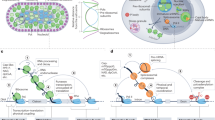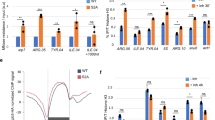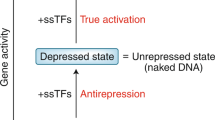Abstract
Transcription by RNA polymerase II in Saccharomyces cerevisiae and in humans is widespread, even in genomic regions that do not encode proteins1,2,3,4,5,6. The purpose of such intergenic transcription is largely unknown, although it can be regulatory7,8. We have discovered a role for one case of intergenic transcription by studying the S. cerevisiae SER3 gene. Our previous results demonstrated that transcription of SER3 is tightly repressed during growth in rich medium9. We now show that the regulatory region of this gene is highly transcribed under these conditions and produces a non-protein-coding RNA (SRG1). Expression of the SRG1 RNA is required for repression of SER3. Additional experiments have demonstrated that repression occurs by a transcription-interference mechanism in which SRG1 transcription across the SER3 promoter interferes with the binding of activators. This work identifies a previously unknown class of transcriptional regulatory genes.
This is a preview of subscription content, access via your institution
Access options
Subscribe to this journal
Receive 51 print issues and online access
$199.00 per year
only $3.90 per issue
Buy this article
- Purchase on Springer Link
- Instant access to full article PDF
Prices may be subject to local taxes which are calculated during checkout




Similar content being viewed by others
References
Cawley, S. et al. Unbiased mapping of transcription factor binding sites along human chromosomes 21 and 22 points to widespread regulation of noncoding RNAs. Cell 116, 499–509 (2004)
Kapranov, P. et al. Large-scale transcriptional activity in chromosomes 21 and 22. Science 296, 916–919 (2002)
Hurowitz, E. H. & Brown, P. O. Genome-wide analysis of mRNA lengths in Saccharomyces cerevisiae. Genome Biol. 5, R2 (2003)
Rinn, J. L. et al. The transcriptional activity of human chromosome 22. Genes Dev. 17, 529–540 (2003)
Saha, S. et al. Using the transcriptome to annotate the genome. Nature Biotechnol. 20, 508–512 (2002)
Chen, J. et al. Identifying novel transcripts and novel genes in the human genome by using novel SAGE tags. Proc. Natl Acad. Sci. USA 99, 12257–12262 (2002)
Gribnau, J., Diderich, K., Pruzina, S., Calzolari, R. & Fraser, P. Intergenic transcription and developmental remodeling of chromatin subdomains in the human β-globin locus. Mol. Cell 5, 377–386 (2000)
Ashe, H. L., Monks, J., Wijgerde, M., Fraser, P. & Proudfoot, N. J. Intergenic transcription and transinduction of the human β-globin locus. Genes Dev. 11, 2494–2509 (1997)
Martens, J. A. & Winston, F. Evidence that Swi/Snf directly represses transcription in S. cerevisiae. Genes Dev. 16, 2231–2236 (2002)
Albers, E., Laize, V., Blomberg, A., Hohmann, S. & Gustafsson, L. Ser3p (Yer081wp) and Ser33p (Yil074cp) are phosphoglycerate dehydrogenases in Saccharomyces cerevisiae. J. Biol. Chem. 278, 10264–10272 (2003)
Cliften, P. et al. Finding functional features in Saccharomyces genomes by phylogenetic footprinting. Science 301, 71–76 (2003)
Kellis, M., Patterson, N., Endrizzi, M., Birren, B. & Lander, E. S. Sequencing and comparison of yeast species to identify genes and regulatory elements. Nature 423, 241–254 (2003)
van Hoof, A., Lennertz, P. & Parker, R. Yeast exosome mutants accumulate 3′-extended polyadenylated forms of U4 small nuclear RNA and small nucleolar RNAs. Mol. Cell. Biol. 20, 441–452 (2000)
Andersen, A. A. & Panning, B. Epigenetic gene regulation by noncoding RNAs. Curr. Opin. Cell Biol. 15, 281–289 (2003)
Hirschman, J. E., Durbin, K. J. & Winston, F. Genetic evidence for promoter competition in Saccharomyces cerevisiae. Mol. Cell. Biol. 8, 4608–4615 (1988)
Emerman, M. & Temin, H. M. Genes with promoters in retrovirus vectors can be independently suppressed by an epigenetic mechanism. Cell 39, 449–467 (1984)
Adhya, S. & Gottesman, M. Promoter occlusion: transcription through a promoter may inhibit its activity. Cell 29, 939–944 (1982)
Corbin, V. & Maniatis, T. Role of transcriptional interference in the Drosophila melanogaster Adh promoter switch. Nature 337, 279–282 (1989)
Cullen, B. R., Lomedico, P. T. & Ju, G. Transcriptional interference in avian retroviruses–implications for the promoter insertion model of leukaemogenesis. Nature 307, 241–245 (1984)
Greger, I. H., Aranda, A. & Proudfoot, N. Balancing transcriptional interference and initiation on the GAL7 promoter of Saccharomyces cerevisiae. Proc. Natl Acad. Sci. USA 97, 8415–8420 (2000)
Hausler, B. & Somerville, R. L. Interaction in vivo between strong closely spaced constitutive promoters. J. Mol. Biol. 127, 353–356 (1979)
Proudfoot, N. J. Transcriptional interference and termination between duplicated alpha-globin gene constructs suggests a novel mechanism for gene regulation. Nature 322, 562–565 (1986)
Valerius, O., Brendel, C., Duvel, K. & Braus, G. H. Multiple factors prevent transcriptional interference at the yeast ARO4-HIS7 locus. J. Biol. Chem. 277, 21440–21445 (2002)
Gottesman, S. Stealth regulation: biological circuits with small RNA switches. Genes Dev. 16, 2829–2842 (2002)
Komarnitsky, P., Cho, E. J. & Buratowski, S. Different phosphorylated forms of RNA polymerase II and associated mRNA processing factors during transcription. Genes Dev. 14, 2452–2460 (2000)
Dudley, A. M., Rougeulle, C. & Winston, F. The Spt components of SAGA facilitate TBP binding to a promoter at a post-activator-binding step in vivo. Genes Dev. 13, 2940–2945 (1999)
Birse, C. E., Lee, B. A., Hansen, K. & Proudfoot, N. J. Transcriptional termination signals for RNA polymerase II in fission yeast. EMBO J. 16, 3633–3643 (1997)
Duina, A. A. & Winston, F. Analysis of a mutant histone H3 that perturbs the association of Swi/Snf with chromatin. Mol. Cell. Biol. 24, 561–572 (2004)
Hirschhorn, J. N., Brown, S. A., Clark, C. D. & Winston, F. Evidence that SNF2/SWI2 and SNF5 activate transcription in yeast by altering chromatin structure. Genes Dev. 6, 2288–2298 (1992)
Dudley, A. M., Gansheroff, L. J. & Winston, F. Specific components of the SAGA complex are required for Gcn4- and Gcr1-mediated activation of the his4-912d promoter in Saccharomyces cerevisiae. Genetics 151, 1365–1378 (1999)
Acknowledgements
We thank A. Dudley, A. Duina and J. Wu for comments on the manuscript. We also thank P. Cliften, P. Sudarsanam and M. Johnston for sharing unpublished results, and J. O'Sullivan and N. Proudfoot for advice on transcription run-on experiments. This work was supported by a grant from the National Institutes of Health to F.W. and by a postdoctoral fellowship from the Canadian Institute for Health Research to J.A.M.
Author information
Authors and Affiliations
Corresponding author
Ethics declarations
Competing interests
The authors declare that they have no competing financial interests.
Supplementary information
Supplementary Table 1
List of S. cerevisiae strains used.
Supplementary Figure 1
Alignment of DNA sequence 5' of the SER3 gene of five related yeasts.
Supplementary Figure 2
Deletion analysis of the SER3 promoter region.
Supplementary Figure 3
Northern analysis of total and poly(A)-enriched RNA.
Supplementary Figure 4
Northern analysis of SRG1, SER3, and SNR190 (loading control) RNA levels in wild type and snf2Δ strains.
Supplementary Figure 5
Quantitation of the ChIP data shown in Figure 4.
Rights and permissions
About this article
Cite this article
Martens, J., Laprade, L. & Winston, F. Intergenic transcription is required to repress the Saccharomyces cerevisiae SER3 gene. Nature 429, 571–574 (2004). https://doi.org/10.1038/nature02538
Received:
Accepted:
Issue Date:
DOI: https://doi.org/10.1038/nature02538
This article is cited by
-
Chance promoter activities illuminate the origins of eukaryotic intergenic transcriptions
Nature Communications (2023)
-
The regulatory function of lncRNA and constructed network in epilepsy
Neurological Sciences (2023)
-
Modular signature of long non-coding RNA association networks as a prognostic biomarker in lung cancer
BMC Medical Genomics (2021)
-
High-resolution analysis of cell-state transitions in yeast suggests widespread transcriptional tuning by alternative starts
Genome Biology (2021)
-
Research updates on the clinical implication of long noncoding RNA in digestive system cancers and chemoresistance
3 Biotech (2021)
Comments
By submitting a comment you agree to abide by our Terms and Community Guidelines. If you find something abusive or that does not comply with our terms or guidelines please flag it as inappropriate.



